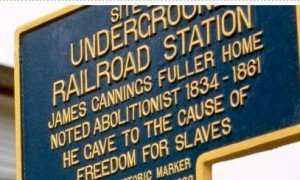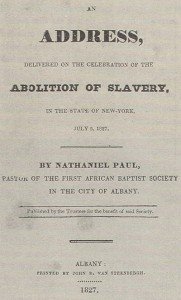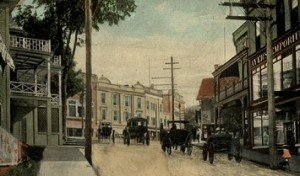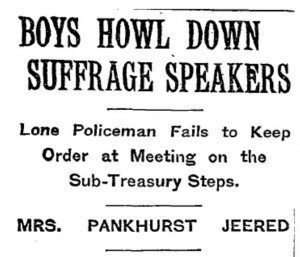 February is Black History Month and New York State offers a special window into African American history and American culture as it was a center for 19th century anti-slavery organizations, and home to Frederick Douglass, Harriet Tubman and many other Abolitionist and Underground Railroad leaders. In the 20th century the National Association of Colored People (NAACP) has its roots in the Niagara Movement, whose first meeting in 1905 took place on the Canadian side of Niagara Falls because members were turned away from hotels on the U.S. side. Read more
February is Black History Month and New York State offers a special window into African American history and American culture as it was a center for 19th century anti-slavery organizations, and home to Frederick Douglass, Harriet Tubman and many other Abolitionist and Underground Railroad leaders. In the 20th century the National Association of Colored People (NAACP) has its roots in the Niagara Movement, whose first meeting in 1905 took place on the Canadian side of Niagara Falls because members were turned away from hotels on the U.S. side. Read more
Report: Progress in Closing Erie Canal Trail Gaps
 Parks &- Trails New York (PTNY) and the Canalway Trails Association New York (CTANY) have released their third annual report, Closing the Gaps: A Progress Report on the Erie Canalway Trail 2012. “Since PTNY and CTANY launched their “Closing the Gaps Campaign” in 2010 in conjunction with U.S. Senator Kirsten Gillibrand, interest in completing the Erie Canalway Trail among citizens, community leaders, and local, state and federal government officials has reached an all-time high,” the groups said in a press release announcing the annual report.
Parks &- Trails New York (PTNY) and the Canalway Trails Association New York (CTANY) have released their third annual report, Closing the Gaps: A Progress Report on the Erie Canalway Trail 2012. “Since PTNY and CTANY launched their “Closing the Gaps Campaign” in 2010 in conjunction with U.S. Senator Kirsten Gillibrand, interest in completing the Erie Canalway Trail among citizens, community leaders, and local, state and federal government officials has reached an all-time high,” the groups said in a press release announcing the annual report.
The report notes efforts in 2012 to close the remaining 84 miles of gaps in the 361-mile trail that extends from Buffalo to Albany: Read more
Book Discussions Focusing on Slavery Set
 “On August 16, 1781, Murphy Stiel, a sergeant in the Black Pioneers, a British paramilitary group based in New York City, had a remarkable dream. Stiel was sleeping in the Pioneers’ barracks on Water Street when he heard “a Voice like a Man’s but saw no body.”
“On August 16, 1781, Murphy Stiel, a sergeant in the Black Pioneers, a British paramilitary group based in New York City, had a remarkable dream. Stiel was sleeping in the Pioneers’ barracks on Water Street when he heard “a Voice like a Man’s but saw no body.”
The voice commanded Stiel to deliver a message to Sir Henry Clinton, commander in chief of the British forces, that he should order General George Washington to surrender “himself and his Troops to the Kings Army.” Failure to do so would mean God’s wrath would fall upon the Americans. Stiel warned that all the “Blacks in America would rise up against Washington’s forces….For…the Lord would be on their side.” Read more
North Country History: The Execution of Allen Mooney
 Despite the physical evidence against Saranac’s Allen Mooney in the murders of Ellen Thomas and Viola Middleton, he could still hope for a lesser conviction, even manslaughter, due to extenuating circumstances. Epilepsy, a weakness for drink, extreme jealousy—the man was obviously beset by many problems. Not a saint by any stretch, but was he a wanton killer? Read more
Despite the physical evidence against Saranac’s Allen Mooney in the murders of Ellen Thomas and Viola Middleton, he could still hope for a lesser conviction, even manslaughter, due to extenuating circumstances. Epilepsy, a weakness for drink, extreme jealousy—the man was obviously beset by many problems. Not a saint by any stretch, but was he a wanton killer? Read more
Peter Feinman: A Fork In The Path Through History
 On January 25, I attended the Mid-Hudson regional meeting of the Path through History project. What follows is my report on the meeting which may, or may not, be the experience and take-away of others who attended (or what is happening in other regions). The Mid-Hudson Valley region includes the Hudson River counties of Westchester, Putnam, Dutchess, Ulster, Orange, and Rockland, along with Sullivan County in the Catskills. Read more
On January 25, I attended the Mid-Hudson regional meeting of the Path through History project. What follows is my report on the meeting which may, or may not, be the experience and take-away of others who attended (or what is happening in other regions). The Mid-Hudson Valley region includes the Hudson River counties of Westchester, Putnam, Dutchess, Ulster, Orange, and Rockland, along with Sullivan County in the Catskills. Read more
Louise Bernikow: Of Super Bowls And Suffragettes
 There’s going to be dancing in the streets of New York City next winter!
There’s going to be dancing in the streets of New York City next winter!
Gotham will host a Super Bowl, putting the city in the same big boys league as Dallas and Miami. As Mayor Michael Bloomberg recently announced, the grand spectacle is coming off after many years of planning by knowledgeable gentlemen with their eyes on hoopla and tourist dollars. Read more
Fort Ticonderogas Garden and Landscape Symposium
 The King’s Garden at Fort Ticonderoga is presenting its second Garden and Landscape Symposium: “Enhancing Life through Gardening” on Saturday, April 13. The day-long symposium, geared for both beginning and experienced gardeners, provides insights from garden experts who live and garden in upstate New York and Vermont. This springtime event takes place in the Deborah Clarke Mars Education Center and is open by pre-registration only.
The King’s Garden at Fort Ticonderoga is presenting its second Garden and Landscape Symposium: “Enhancing Life through Gardening” on Saturday, April 13. The day-long symposium, geared for both beginning and experienced gardeners, provides insights from garden experts who live and garden in upstate New York and Vermont. This springtime event takes place in the Deborah Clarke Mars Education Center and is open by pre-registration only.
The walled King’s Garden was originally designed in 1921 by leading landscape architect Marian Coffin. The formal elements – a reflecting pool, manicured lawn and hedges, and brick walls and walkways – are softened by a profusion of annuals and perennials, carefully arranged by color and form. Heirloom flowers and modern cultivars are used to recreate the historic planting scheme. Read more
This Weeks Top New York History News
This Weeks New York History Web Highlights
Highlighting Some Innovative Practices
 Many of the entries and news items here at the New York History blog highlight innovative practices and initiatives to broaden public visibility and support.
Many of the entries and news items here at the New York History blog highlight innovative practices and initiatives to broaden public visibility and support.
Sharing information and descriptions of good practices is a useful strategy for strengthening our programs. Here are a few examples that may be of interest:
Read more
